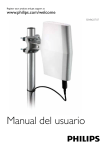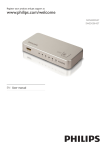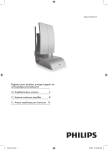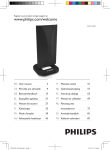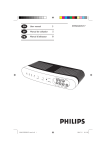Download Philips SDV8625T
Transcript
Register your product and get support at www.philips.com/welcome SDV8625T/27 EN User manual 1 Important 4 4 4 4 4 5 5 2 Your SDV8625T/27 5 6 Safety For indoor use For outdoor use Notice for USA Notice for Canada Recycling What’s in your box English Contents 3 Get started 7 Installation 7 Connect to the TV 10 Set up a digital tuner with this antenna 10 4 Frequently asked questions 11 5 Warranty and service 11 6 Glossary 12 EN 3 1 Important Safety • Properly sealed against leaks at the installation site. • Do not install your antenna on a wet or windy day. • If the assembly starts to drop, get away from it immediately. Remember: the antenna, mast, cable, and metal guy wires are all excellent conductors of electrical current. Even the slightest touch of any of these parts to a power line can cause electrocution and death. • If any part of the antenna system should come in contact with a power line, don’t touch it or try to remove it yourself. Call your local power company. They will remove it safely. • If an accident occurs with the power lines, call for qualified emergency help immediately. This manual contains important information about the Philips indoor/outdoor television antenna. Read it carefully before you start the installation and setup. For indoor use • The product shall not be exposed to dripping or splashing and no objects filled with liquid, such as vases, shall be placed on the product. • To completely disconnect the power input, the main plug of the product shall be disconnected from the main AC outlet. • Where the main plug is used as the disconnect device, the disconnect device shall remain readily operable. • No naked flame sources, such as lighted candles, should be placed on the product. For outdoor use • If this is the first time you install an antenna, for your own safety as well as others, seek professional assistance. • Perform as many functions as possible on the ground. • Select your installation site carefully. Remember: electric power lines and phone lines look alike. For your safety, assume that all overhead lines may cause fatal injury. • Ensure that the installation site is structurally capable to support all loads (weight of the antenna, weight of ice, weight of snow and wind force). 4 EN Notice for USA This equipment has been tested and found to comply with the limits for a Class B digital device, pursuant to part 15 of the FCC Rules. These limits are designed to provide reasonable protection against harmful interference in a residential installation. This equipment generates, uses and can radiate radio frequency energy and, if not installed and used in accordance with the instruction manual, may cause harmful interference to radio communications. However, there is no guarantee that interference will not occur in a particular installation. If this equipment does cause harmful interference to radio or television reception, which can be determined by turning the equipment off and on, the user is encouraged to try to correct the interference by one or more of the following measures: • Relocate the receiving antenna. • Increase the separation between equipment and receiver. Connect the equipment into an outlet on a circuit different from that to which the receiver is connected. • Consult the dealer or an experienced radio/TV technician for help. All other devices shall bear the following statement in a conspicuous location on the device: This device complies with part 15 of the FCC Rules. Operation is subject to the following two conditions: (1) This device may not cause harmful interference, and (2) this device must accept any interference received, including interference that may cause undesired operation. The packaging of this product is intended to be recycled. Contact your local authorities for information about how to recycle the packaging. When this logo is attached to a product, it means a financial contribution has been paid to the associated national recovery and recycling system. © 2011 Koninklijke Philips Electronics N.V. All rights reserved. Reproduction in whole or in part is prohibited without the written consent of the copyright owner. Trademarks are the property of Koninklijke Philips Electronics N.V. or their respective owners. Notice for Canada Class B Clause This digital apparatus does not exceed the Class B limits for radio noise emissions from digital apparatus as set out in the Radio Interference Regulations of the Canadian Department of Communications. 2 Your SDV8625T/27 This Class B digital apparatus complies with Canadian ICES-003. Congratulations on your purchase and welcome to Philips! Recycling To fully benefit from the support that Philips offers, register your product at www.philips. com/welcome. Your product is designed and manufactured with high quality materials and components, which can be recycled and reused. Never dispose of your product with other household waste. Please inform yourself about the local rules on the separate collection of electrical and electronic products. The correct disposal of your old product helps prevent potentially negative consequences on the environment and human health. EN 5 English • What’s in your box 1 3 2 1x 1x 5 6 2x 9 10 2x 1x 1x 7 8 1x 4x 4x 12 11 1x 4 13 4x 1x 14 1x a SDV8625T/27 antenna h 25mm wood screws b Power supply 100-240V AC / 6V DC 500mA i 6m coax cable with connectors j Weather boot c Wall/Mast bracket k Power injector d Nut l Plastic anchors e U-Bolts m Washer f Mast clamps n 40mm Hexagon screw g Nuts with lock washers 6 EN Installation Installation information This antenna uses a power inserter module to power the antenna amplifier. It is essential for proper operation of this antenna system that the power inserter be connected between the antenna and any devices such as splitters, matching transformers, networks, etc. Determine the signal strength Before Installation, determine the best location for optimum reception. It is important for the antenna to have an unobstructed path to the transmitter. For best results, ensure the antenna faces the location of the transmitter. Note •• Indoor, choose a location near a window which gives the antenna a clear view of the transmitter. Note •• Place the antenna away from metal surface to avoid interference. a For indoor wall mount installation Note •• Complete all assembly work on the ground b before installing on a wall or an antenna mast. 1 c Use the nut , washer , and hexagon screw to attach the antenna to the wall/mast bracket. d a b c d Antenna with built-in amplifier Power inserter module Splitters or matching transformers (not included) TV or video device 2 Use the screw holes of the wall/mast bracket as a guide to mark position for the wood screws. EN 7 English 3 Get started For outdoor mast mount installation Note •• Complete all assembly work on the ground. Raise the completed antenna after assembly. 1 3 Use the nut , washer , and hexagon screw to attach the antenna to the wall/mast bracket. For wood wall Use the wood screws to fix the antenna to the wood wall firmly. 3.2mm (1/8”) 27±5mm 1.1”±0.2” For concrete wall Drill four holes on concrete wall, put four plastic anchors into the holes. Use wood screws to fix the antenna to the concrete wall firmly. 7.9mm (5/16”) 35±5mm 1.4”±0.2” 8 EN 2 Insert U-bolts into the holes of the wall/mast bracket . Slide the mast clamps onto the U-bolts . Attach the four nuts with lock washers to the U-bolts . 3 Attach the assembly to the mast firmly. Rotate 4 5 English You can make a 90 degree rotation to the antenna or the mounting post. Rotate the mast in its mount to adjust the direction. Attach the coaxial cable to the F connector on the underside of the unit. Position the weather boot over the connection. EN 9 Warning •• The power injector and power supply are for indoor use only. Tip •• This antenna includes a 19.7ft roll of 3C-2V coaxial cable. If this is not adequate for your needs, replace the cable with a RG-6 coaxial cable instead of adding an extension. Set up a digital tuner with this antenna Connect to the TV Note •• As previously noted, the amplifier (Power injector + Power supply) must be placed inline between the antenna and any splitter or additional devices. 1 2 3 10 Connect the coaxial cable from the antenna to the connector labeled ANT on the power injector . Connect the power injector to the antenna input on the TV, digital set-top box, splitter or other devices. Connect the power supply plug to the power injector , and then plug the power supply adaptor into a 100-240V AC receptacle. EN You can install available channels with the digital TV tuner. This automatic process is part of the setup of the tuner. Ensure the antenna has set up properly before the tuner can receive viewable channels. There are two ways to connect the antenna to the TV: • Connect the antenna to a digital tuner. If the signal strength is good enough, the channels can be memorized in the tuner automatically . • Connect the antenna directly to the TV. Tune to the analogue channels and find the best antenna location. Then reconnect the antenna to the digital tuner. Ensure the signal strength is good enough before you install the channels with the tuner. 5 Warranty and service Can this antenna work with Analogue transmissions? Yes, this antenna can receive analogue television broadcasts in the UHF and VHF bandwidths. Warranty information can be found at: www. philips.com/welcome Can this antenna receive digital or work with ATSC broadcasts? Yes, this antenna is designed to receive ATSC and HDTV broadcasts in the UHF & VHF bandwidths. Can the antenna be powered by a DC power supply in a boat, RV or camper? Yes, there is a DC power socket located at the back of the antenna. Plug your cable/adapter into the antenna and then into your power source. Where should I place the antenna in order to get the best reception possible? Choose a location near a window which gives the antenna a clear view of the transmitter. Tip •• For best reception, place the antenna away from metal surface to avoid interference. Can I set up this antenna with a digital tuner? Yes, this antenna can be set up with a digital tuner (see the section on “Set up a digital tuner with this antenna”). English 4 Frequently asked questions For technical support, send us an email with the model number of the product and a detailed description of your problem to:[email protected] Limited One-Year Warranty Philips warrants that this product shall be free from defects in material, workmanship and assembly, under normal use, in accordance with the specifications and warnings, for one year from the date of your purchase of this product. This warranty extends only to the original purchaser of the product, and is not transferable. To exercise your rights under this warranty, you must provide proof of purchase in the form of an original sales receipt that shows the product name and the date of purchase. For customer support or to obtain warranty service, please call 1-919-573-7854. THERE ARE NO OTHER EXPRESS OR IMPLIED WARRANTIES. The liability of Philips is limited to repair or, at its sole option, replacement of the product. Incidental, special and consequential damages are disclaimed where permitted by law. This warranty gives you specific legal rights. You may also have other rights that vary from state to state. Warranty information can also be found at: www.philips.com/welcome EN 11 6 Glossary F A FM (Frequency Modulation) In radio broadcasting: a method of modulation in which the frequency of the carrier voltage is varied with the frequency of the modulation voltage. Amplifier A device, either a single stage or a large scale circuit with multiple stages for creating gain, i.e. it makes small signals larger. Antenna A device, such as a rod or wire, which picks up a received radio frequency signal or radiates a transmitted RF signal. ATSC (Advanced Television Systems Committee) The Advanced Television Systems Committee, Inc., is an international, non-profit organization developing voluntary standards for digital television. The high definition television standards defined by the ATSC produce wide screen 16:9 images up to 1920x1080 pixels in size -- more than six times the display resolution of the earlier standard. However, many different image sizes are also supported, so that up to six standard-definition “virtual channels” can be broadcast on a single 6 MHz TV channel. C Coaxial A single copper conductor, surrounded with a layer of insulation, covered by a surrounding copper shield and finally, an insulating jacket. An unbalanced transmission line with constant impedance. In audio, this type is commonly used for low level, line signals terminated in RCA connectors. 12 EN H HDTV (High-Definition Television) It is a digital television broadcasting system with higher resolution than traditional television systems (standard-definition TV, or SDTV). HDTV is digitally broadcast; the earliest implementations used analog broadcasting, but today digital television (DTV) signals are used, requiring less bandwidth due to digital video compression. U UHF (Ultra high frequency) In radio or TV broadcasting: it is the frequency range of electromagnetic waves which lies between 300 MHz and 3 GHz (3000 MHz). V VHF (Very high frequency) In radio or TV broadcasting: it is the frequency range of electromagnetic waves which lies between 30 MHz and 300 MHz. © 2011 Koninklijke Philips Electronics N.V. All rights reserved. DFU_SDV8625T_27_V1.1















